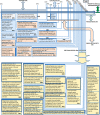Swimming microorganisms acting as nanorobots versus artificial nanorobotic agents: A perspective view from an historical retrospective on the future of medical nanorobotics in the largest known three-dimensional biomicrofluidic networks
- PMID: 27158285
- PMCID: PMC4841799
- DOI: 10.1063/1.4945734
Swimming microorganisms acting as nanorobots versus artificial nanorobotic agents: A perspective view from an historical retrospective on the future of medical nanorobotics in the largest known three-dimensional biomicrofluidic networks
Abstract
The vascular system in each human can be described as a 3D biomicrofluidic network providing a pathway close to approximately 100 000 km in length. Such network can be exploited to target any parts inside the human body with further accessibility through physiological spaces such as the interstitial microenvironments. This fact has triggered research initiatives towards the development of new medical tools in the form of microscopic robotic agents designed for surgical, therapeutic, imaging, or diagnostic applications. To push the technology further towards medical applications, nanotechnology including nanomedicine has been integrated with principles of robotics. This new field of research is known as medical nanorobotics. It has been particularly creative in recent years to make what was and often still considered science-fiction to offer concrete implementations with the potential to enhance significantly many actual medical practices. In such a global effort, two main strategic trends have emerged where artificial and synthetic implementations presently compete with swimming microorganisms being harnessed to act as medical nanorobotic agents. Recognizing the potentials of each approach, efforts to combine both towards the implementation of hybrid nanorobotic agents where functionalities are implemented using both artificial/synthetic and microorganism-based entities have also been initiated. Here, through the main eras of progressive developments in this field, the evolutionary path being described from some of the main historical achievements to recent technological innovations is extrapolated in an attempt to provide a perspective view on the future of medical nanorobotics capable of targeting any parts of the human body accessible through the vascular network.
Figures


References
-
- Feynman R. P., Eng. Sci. (CalTech) 23, 22 (1960).
-
- R. B. Freitas, Jr. , “ Current status of nanomedicine and medical nanorobotics,” J. Comput. Theor. Nanosci. 2, 1–25 (2005).
-
- Purcell E. M., Am. J. Phys. 45, 3–11 (1977).10.1119/1.10903 - DOI
-
- Drexler K. E., Nanosystems: Molecular Machinery, Manufacturing, and Computation ( John Wiley & Sons, New York, 1992).
LinkOut - more resources
Full Text Sources
Other Literature Sources
